
Imperial War Museums (IWM) is a British national museum organisation with branches at five locations in England, three of which are in London. Founded as the Imperial War Museum in 1917, the museum was intended to record the civil and military war effort and sacrifice of Britain and its Empire during the First World War. The museum's remit has since expanded to include all conflicts in which British or Commonwealth forces have been involved since 1914. As of 2012, the museum aims "to provide for, and to encourage, the study and understanding of the history of modern war and 'wartime experience'."

Duxford is a village in Cambridgeshire, England, about 10 miles (16 km) south of Cambridge. It is part of the Hundred Parishes area.

Wimbledon is a National Rail, London Underground, and Tramlink station located on Wimbledon Bridge, Wimbledon in London, and is the only London station that provides an interchange between main line rail, Underground, and Tramlink. The station serves as a junction for services from the Underground's District line and National Rail operators, as well as Tramlink services. Some weekday peak services on the Thameslink route are provided by Southern. The station is in Travelcard Zone 3. It is 7 miles 19 chains (11.6 km) from London Waterloo on the South Western main line.

The Hawker Hind was a British light bomber of the inter-war years produced by Hawker Aircraft for the Royal Air Force. It was developed from the Hawker Hart day bomber introduced in 1931.

A warbird is any vintage military aircraft now operated by civilian organizations and individuals or, in some instances, by historic arms of military forces, such as the Battle of Britain Memorial Flight, the RAAF Museum Historic Flight or the South African Air Force Museum Historic Flight.

The Jagdpanther, Sd.Kfz. 173, was a highly-successful tank destroyer built by Germany during World War II based on the chassis of the Panther tank. It entered service in 1944 during the later stages of the war on the Eastern and Western Fronts. The Jagdpanther combined the 8.8 cm Pak 43 cannon, similar to the main gun of the Tiger II, and the armor and suspension of the Panther chassis. During the last stages of the war, limited German production resulted in small production numbers, shortage of spare parts, and shortened crew training periods of younger operators.

Imperial War Museum Duxford is a branch of the Imperial War Museum near Duxford in Cambridgeshire, England. Britain's largest aviation museum, Duxford houses the museum's large exhibits, including nearly 200 aircraft, military vehicles, artillery and minor naval vessels in seven main exhibition buildings. The site also provides storage space for the museum's other collections of material such as film, photographs, documents, books and artefacts. The site accommodates several British Army regimental museums, including those of the Parachute Regiment and the Royal Anglian Regiment.

HM Coastal Motor Boat 4 is the torpedo boat used when Lieutenant Augustus Agar earned a Victoria Cross for carrying out a raid on Soviet warships in Kronstadt and sinking the cruiser Oleg

Standard Car 4x2, or Car Armoured Light Standard, better known as the Beaverette, was a British armoured car produced during the Second World War.

Duxford Aerodrome is located 8 nautical miles south of Cambridge, within the Parish of Duxford, Cambridgeshire, England and nearly 1-mile (1.6 km) west of the village.

MediaCityUK tram stop is a stop on Greater Manchester's Metrolink light rail system. It is located in MediaCityUK, in Salford, North West England, and serves MediaCityUK, The Lowry, the Imperial War Museum North and other parts of Salford Quays. It opened on 20 September 2010, as the terminus of a specially-constructed 360-metre-long spur (0.22 mi) from the Eccles Line.
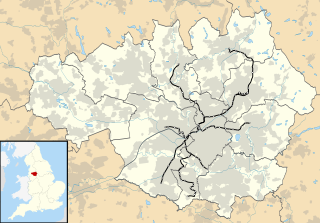
Imperial War Museum is a tram stop built for Greater Manchester's Metrolink light rail system. It is located on Trafford Wharf Road and serves the Imperial War Museum North, ITV Studios and MediaCityUK. It opened on 22 March 2020,
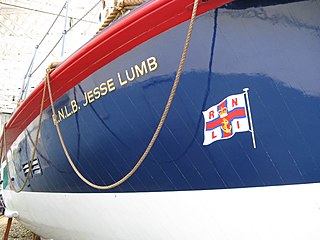
RNLB Jesse Lumb is a historic lifeboat. Built by J. Samuel White in 1939, Jesse Lumb served as the lifeboat at Bembridge on the Isle of Wight from 1939 to 1970, becoming the last of her type in service. Since 1980 she has been preserved at Imperial War Museum Duxford. In August 1999 she was inscribed on the National Register of Historic Vessels, becoming part of the National Historic Fleet.
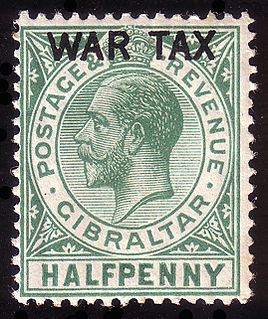
The Wilson-Todd collection is a collection of postage stamps issued during, or associated with, the First World War, including many war tax stamps, that forms part of the British Library Philatelic Collections. It was created by James Wilson-Todd and donated to the British Museum by his mother Lady Wilson-Todd after his death. As of April 2008 it was held in one box.
The Imperial War Museum stamp collection is a collection of postage stamps issued during, or associated with, the First World War that is on loan from the Imperial War Museum to the British Library philatelic collections. The collection is rich in material from the former Ottoman Empire. As of October 2007 it consisted of 13 large boxes and a book, Imperial War Museum Stamp Collections by Country, that lists the items held.

Spur Battery is an artillery battery in the British Overseas Territory of Gibraltar. It is located in the Upper Battery area of the southern end of the Upper Rock Nature Reserve, just southwest of O'Hara's Battery. A 9.2-inch Mark X breech-loading gun was mounted on the emplacement in 1902, with improvements made to the battery after World War I. In 1981 the 9.2-inch gun at Spur Battery was dismantled and transferred to the Imperial War Museum in Duxford, England, for preservation. The operation was known as Project Vitello.
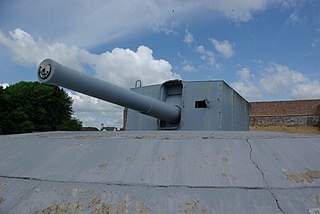
Project Vitello was a military operation that transferred the 9.2-inch Mark X breech-loading gun at Spur Battery in the British Overseas Territory of Gibraltar to the Imperial War Museum in Duxford, Cambridgeshire, England. Project Vitello I, the first phase, entailed the dismantling of the gun by the Royal Engineers at the artillery battery and transporting it to the Gibraltar dockyard in 1981. It was then shipped to Portsmouth on a Royal Fleet Auxiliary vessel. Project Vitello II, the second phase, began with the arrival of the gun in Portsmouth and involved transporting the gun to the Duxford Aerodrome. The Royal Engineers not only reassembled the gun and its mount, but also constructed a base, shell pit, and parapet, with the operation completed in 1982. The Gibraltar Gun was inaugurated that year by Sir John Grandy, Chairman of the Trustees of the Imperial War Museum.
The Ven. Guy Mayfield was Archdeacon of Hastings from 1956 to 1975.
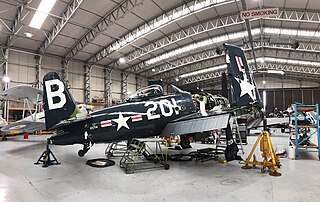
The Fighter Collection is a private operator of airworthy vintage military aircraft or warbirds. It is based in the United Kingdom at Duxford Aerodrome in Cambridgeshire, an airfield that is owned by the Imperial War Museum and is also the site of the Imperial War Museum Duxford. It is registered as a Private limited company.
















